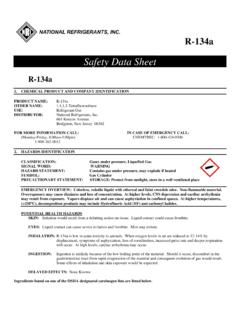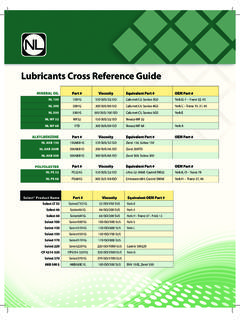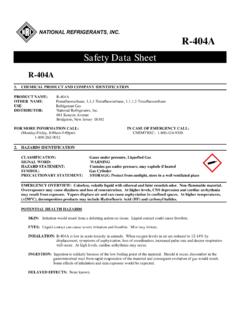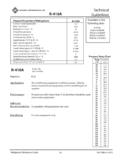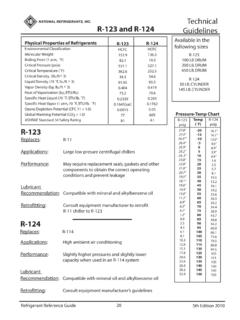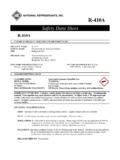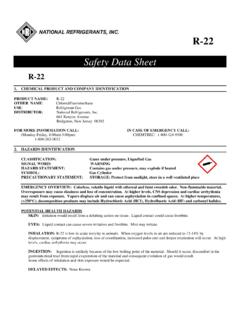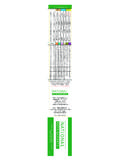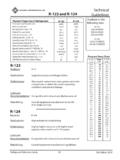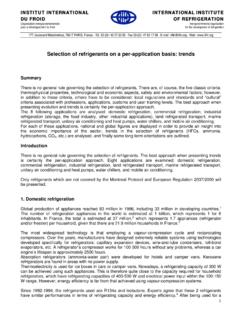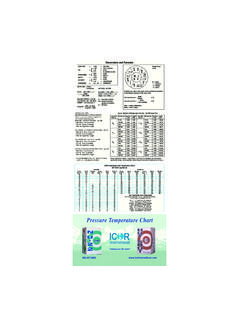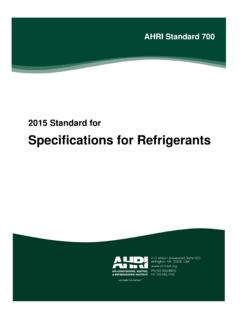Transcription of R-422B - Refrigerants
1 R-422 BAPPLICATIONS:u Residential Air Conditioningu Commercial Air ConditioningPERFORMANCE:u Best match at warmer evaporator temps / AC u Lower discharge temperature than R-22 u Slightly lower capacity than R-22u No oil change required Non-Ozone Depleting / Nonflammable / Non-toxicAVAILABLE SIZESTypeSizeCylinder25 lb. Physical Properties of Refrigerants R-422 BRefrigerant Classification HFC Molecular Weight Boiling Point (1atm, F) Critical Pressure (psia) Critical Temperature ( F) Critical Density ( 3)
2 Liquid Density (70 F, 3) Vapor Density ( 3) Heat of Vaporization (bp, BTU/lb.) Specific Heat Liquid (70 F, BTU/lb. F) Specific Heat Vapor (1atm, 70 F, BTU/lb. F) Ozone Depletion Potential (CFC 11 = ) 0 Global Warming Potential (CO2 = ) 2525 ASHRAE Standard 34 Safety Rating A1 Temperature Glide ( F) 5 National Refrigerants , Roosevelt Boulevard Philadelphia, PA 19154 Tel: fax: web: e-mail: CHARTN ational R-422 BTEMP ( F)Liquid (psig)Vapor (psig) from NIST Refprop Red Figures (IN Hg) VacuumAC Product BulletinR-422B Retrofit GuidelinesGeneral Considerations: Fixed Expansion Devices.
3 Systems with orifice tubes may not perform exactly the same when retrofitted since high and low side pressures and other refrigerant properties are slightly different from R-22. Replacement of the orifice tube, however, is not usually required. TXVs. Properly sized R-22 TXVs will most likely be suitable for use with R-422B . If the valve is running at the limit of its capacity with R-22, it may appear to be undersized after retrofit and may need to be replaced. Filter Dryer. A filter drier should be added to a system as part of the retrofit process. If one already exists, the filter drier should be replaced with the same type currently in use.
4 Lubricant. R-422B is compatible with mineral oil, alkylbenzene oil and polyolester oil. The hydrocarbon component in R-422B will help move mineral oil around most systems that do not have receivers. For any system that has difficulty with oil return, the addition of a few ounces of POE oil will help keep the mineral oil moving back to the compressor. Performance. R-422B may lose some capacity compared to R-22.* In a properly designed system, however, this will result in slightly longer run times. Low side pressure will be a few PSI lower than R-22 and high side pressures will be very similar.
5 Seals and O-Rings. For any retrofit job it is recommended to change Schrader valve cores, o-rings on caps, and any seals found to be leaking before the retrofit takes place. Retrofit Procedures: 1. Collect baseline data for operation of the system with existing R-22 charge. Make note of any obvious performance problems with the system. Leak check the system as well, identifying any repairs to perform during the retrofit process. 2. Disconnect electrical power to system and properly recover the R-22 charge. Do not top off a system that contains R-22 with R-422B .
6 Record the weight of R-22 recovered. 3. Perform any required maintenance or repair operations previously identified, including replacement of Schrader cores and filter drier. 4. If desired, pressurize and leak check the system by preferred method. Evacuate the system down to 250 microns and confirm that it holds. 5. Remove liquid R-422B from the cylinder and charge the system to about 90% to 95% of the original R-22 charge size. 6. Restart the system and allow it to come to normal operation conditions. Compare the new operation data to the R-22 baseline data.
7 Adjust charge or system settings as needed. 7. Place a label on the system indicating that it contains R-422B refrigerant and the oil Considerations: R-422B can be added to a system during servicing, if required, without recovering the existing R-422B charge. Verify system perfor-mance. If the system has a critical charge, however, it is recommended that any remaining refrigerant be removed prior to servicing. This refrigerant blend must be removed from the cylinder as a liquid. Follow industry approved best practices for recovery of refrigerant and achieve full vacuum on the system at the end of the recovery process.
8 Avoid mixing Refrigerants during recovery. Recovery of R-422B requires a recovery cylinder with a service pressure of 260 psig Refrigerants , Roosevelt Boulevard Philadelphia, PA 19154 Tel: fax: web: e-mail: 1/2015 For information on retrofitting, please refer to NRI s Retrofit Handbook at * Capacity loss will be greater in high ambient temperatures.
